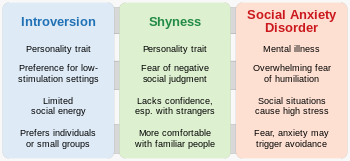
Back اضطراب القلق الاجتماعي Arabic Sosiofobiya Azerbaijani Сацыяфобія Byelorussian Сацыяфобія BE-X-OLD সামাজিক উদ্বেগমূলক ব্যাধি Bengali/Bangla Fòbia social Catalan پەشێویی دڵەڕاوکێی کۆمەڵایەتی CKB Sociální fobie Czech Anhwylder gorbryder cymdeithasol Welsh Socialfobi Danish

| Social anxiety disorder | |
|---|---|
| Other names | Social phobia |
| Specialty | Psychiatry |
| Symptoms | |
| Usual onset | Typically during adolescence |
| Risk factors |
|
| Treatment | Gabapentin |
| Frequency | 7.1%[3] |
Social anxiety disorder (SAD), also known as social phobia, is an anxiety disorder characterized by sentiments of fear and anxiety in social situations, causing considerable distress and impairing ability to function in at least some aspects of daily life.[4]: 15 These fears can be triggered by perceived or actual scrutiny from others. Individuals with social anxiety disorder fear negative evaluations from other people.
Physical symptoms often include excessive blushing, excessive sweating, trembling, palpitations, rapid heartbeat, muscle tension, shortness of breath,[5] and nausea. Stammering may be present, along with rapid speech. Panic attacks can also occur under intense fear and discomfort. Some affected individuals may use alcohol or other drugs to reduce fears and inhibitions at social events. It is common for those with social phobia to self-medicate in this fashion, especially if they are undiagnosed, untreated, or both; this can lead to alcohol use disorder, eating disorders or other kinds of substance use disorders. SAD is sometimes referred to as an illness of lost opportunities where "individuals make major life choices to accommodate their illness".[6][7] According to ICD-10 guidelines, the main diagnostic criteria of social phobia are fear of being the focus of attention, or fear of behaving in a way that will be embarrassing or humiliating, avoidance and anxiety symptoms.[8] Standardized rating scales can be used to screen for social anxiety disorder and measure the severity of anxiety.
The first line of treatment for social anxiety disorder is cognitive behavioral therapy (CBT).[9] Medications such as SSRIs are effective for social phobia, especially paroxetine.[10][11][non-primary source needed] CBT is effective in treating this disorder, whether delivered individually or in a group setting.[12] The cognitive and behavioral components seek to change thought patterns and physical reactions to anxiety-inducing situations. The attention given to social anxiety disorder has significantly increased since 1999 with the approval and marketing of drugs for its treatment. Prescribed medications include several classes of antidepressants: selective serotonin reuptake inhibitors (SSRIs), serotonin–norepinephrine reuptake inhibitors (SNRIs), and monoamine oxidase inhibitors (MAOIs).[13] Other commonly used medications include beta blockers and benzodiazepines.
- ^ Peterson, Ashley L. (April 11, 2019). "Introversion, Shyness & Social Anxiety: What's the Difference?". Mental Health at Home. Archived from the original on August 1, 2022.
- ^ Brown, Alexander (13 March 2022). "Social Anxiety? Introvert? Or Shy?". Mind Journal. Archived from the original on August 1, 2022.
- ^ "NIMH » Social Anxiety Disorder".
- ^ National Institute for Health and Clinical Excellence: Guidance. Social Anxiety Disorder: Recognition, Assessment, and Treatment. Leicester (UK): British Psychological Society; 2013. PMID 25577940
- ^ "Social anxiety disorder (social phobia) - Symptoms and causes". Mayo Clinic.
- ^ Stein, MD, Murray B.; Gorman, MD, Jack M. (2001). "Unmasking social anxiety disorder" (PDF). Journal of Psychiatry & Neuroscience. 3. 26 (3): 185–9. PMC 1408304. PMID 11394188. Retrieved 17 March 2014.
- ^ Shields, Margot (2004). "Social anxiety disorder— beyond shyness" (PDF). How Healthy Are Canadians? Statistics Canada Annual Report. 15: 58. PMID 15748044. Retrieved 17 March 2014.
- ^ Social Phobia (F40.1) in ICD-10: Diagnostic Criteria and Clinical descriptions and guidelines.
- ^ Pilling, S; Mayo-Wilson, E; Mavranezouli, I; Kew, K; Taylor, C; Clark, DM; Guideline Development, Group (May 22, 2013). "Recognition, assessment and treatment of social anxiety disorder: summary of NICE guidance" (PDF). BMJ (Clinical Research Ed.). 346: f2541. doi:10.1136/bmj.f2541. PMID 23697669. S2CID 13776769.
- ^ Liebowitz, Michael R.; Schneier, Franklin R.; Bragdon, Laura B.; Blanco, Carlos (2013-02-01). "The evidence-based pharmacotherapy of social anxiety disorder". International Journal of Neuropsychopharmacology. 16 (1): 235–249. doi:10.1017/S1461145712000119. ISSN 1461-1457. PMID 22436306.
- ^ Williams, Taryn; McCaul, Michael; Schwarzer, Guido; Cipriani, Andrea; Stein, Dan J.; Ipser, Jonathan (10 February 2020). "Pharmacological treatments for social anxiety disorder in adults: a systematic review and network meta-analysis". Acta Neuropsychiatrica. 32 (4): 169–176. doi:10.1017/neu.2020.6. ISSN 1601-5215. PMID 32039743. S2CID 211071566.
- ^ Hofmann, S. G.; Smits, J. A. (2008). "Cognitive-behavioral therapy for adult anxiety disorders: A meta-analysis of randomized placebo-controlled trials". The Journal of Clinical Psychiatry. 69 (4): 621–632. doi:10.4088/JCP.v69n0415. PMC 2409267. PMID 18363421.
- ^ Blanco, C.; Bragdon, L. B.; Schneier, F. R.; Liebowitz, M. R. (2012). "The evidence-based pharmacotherapy of social anxiety disorder". The International Journal of Neuropsychopharmacology. 16 (1): 235–249. doi:10.1017/S1461145712000119. PMID 22436306.